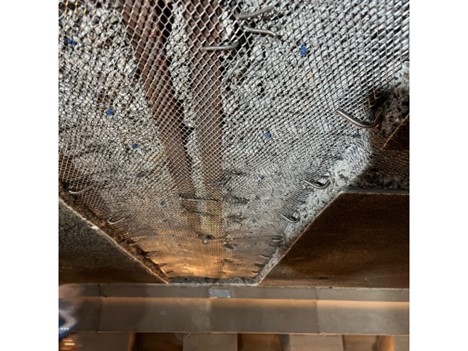Restoring a Landmark Without Slowing Manhattan
- eva_hatzaki
- Aug 21
- 9 min read
A behind-the-scenes look at how engineers safely restored the viaduct ceiling under Park Avenue’s historic Helmsley Building.

The Park Avenue Viaduct, one of Midtown Manhattan’s busiest roadways, runs through the base of the 35-story Helmsley Building. Since the ceilings of the two arched tunnels are part of the 35-story Beaux-Arts building’s exterior wall system, they are subject to compliance with New York City’s Façade Inspection and Safety Program regulations. - PHOTO: ALEXANDER SEVERIN

By: Jun Yu, Ph.D., P.E., LEED AP BD+C Senior Principal
Kunal Badheka, P.E. Principal
David Campos Project Engineer
Every day in Midtown Manhattan, thousands of vehicles pass through the Park Avenue Viaduct – not around the city’s architecture, but directly through it. At 230 Park, the viaduct cuts straight through the base of the Helmsley Building – formerly known as the New York Central Building – entering and exiting through two arched openings built into the structure’s ground floor.
Luckily, we found a couple of original structural drawings about this ceiling to help us to understand - the viaduct ceiling isn’t part of the roadway, it’s a suspended cinder concrete slab, reinforced with wire mesh and hung from the fourth-floor framing above, structurally tied into the building itself. From street level, it reads like a typical underpass. In reality, it’s a part of the building envelope embedded within a 35-story Beaux-Arts high-rise – one that must be quietly and properly maintained and repaired while accommodating the constant movement of the city below.
When signs of deterioration began to appear along the tunnel ceiling, it wasn’t just a maintenance concern. It raised structural questions. What was happening behind the surface? How deep did the deterioration go? Are there any damaged conditions which pose potential hazard to the passengers and vehicles? How soon will it be before these conditions become unsafe? How do you assess and repair this tunnel ceiling suspended inside a landmark while traffic continues to move beneath it?
Thornton Tomasetti was already engaged by the building management – RXR – for façade repairs at the Helmsley Building under the city’s FISP (Façade Inspection & Safety Program, a.k.a. Local Law 11/98) program, administrating a larger façade restoration effort performed by Skyline Restoration and other contractors. As part of the due diligence process, our team recognized that the viaduct ceiling was also part of the building’s exterior wall system, which needed to comply with the latest FISP rule. Working together, we engineered a solution that would restore safety without triggering costly shutdowns, lengthy permit approvals, or disruptions to a major Midtown corridor.
During a New York City Façade Inspection and Safety Program examination, Thornton Tomasetti and Skyline Restoration uncovered fine cracking, efflorescence and staining in the viaduct ceiling indicating an issue with water intrusion. - PHOTO: THORNTON TOMASETTI
Diagnosing Damage
Before any solution could be designed, we had to understand what was happening behind the tunnel ceiling. The ceiling first raised concern during routine inspections tied to the FISP examination work. Fine cracking, efflorescence and subtle staining hinted at water intrusion. But without visible deflection or failure, the severity and extent of the problem was impossible to gauge, especially observed from the street level.
Given the constraints of being a landmark building above an active roadway, we developed a targeted probe investigation program that allowed us to assess conditions from accessible points while preserving the integrity of the ceiling. Using boom lifts operated by the contractor during the weekend nights when the viaduct was shut down in one lane, our engineers accessed both visibly damaged and undisturbed zones, gathering critical information to diagnose the extent of deterioration, minimizing the disruption to normal operations.
We began with hammer sounding surveys of the viaduct ceiling to detect hollow-sounding areas – early clues of delamination – then followed with localized probes to verify what was happening below the surface. These techniques gave us clarity without compromise, enabling real-time diagnostics without removing or disturbing the broader system.
The viaduct ceiling is constructed of a suspended cinder slab reinforced with wire mesh. Damaged wire mesh was replaced with new material to restore load continuity. - PHOTO: THORNTON TOMASETTI
What we found confirmed our instincts. This wasn’t just a decorative ceiling; it was a carefully engineered, suspended assembly. One inch of plaster concealed four inches of cinder concrete slab, reinforced with a single layer of wire mesh, spanning between steel beams. The entire slab support framing was held aloft by steel hangers connected to the fourth-floor framing above – a design solution from the early 20th century that blended architectural elegance with structural logic. It was a smart system. But it was aging, after almost a century.
While most of the ceiling remained intact, the areas near historical leaks told a different story. While the leak source, those hanged water conduits under the 4th floors structural framing, was fixed previously, water intrusion had weakened the cinder concrete in key spots. In several locations, the embedded mesh and supporting steel framing showed early signs of corrosion. The damage wasn’t widespread – but where it existed, it posed a potential risk to long-term performance.
That was the inflection point. We now had the data we needed to act, not broadly, but surgically. With a clear understanding of what lay above and beneath the surface, we were ready to design a deliberate, efficient and precisely scoped repair program that addressed the true conditions on site.
A Tiered Repair Strategy
Repairing a ceiling like this isn’t about one fix – it’s about matching method to condition. Working closely with Skyline, we created a decision-making matrix to guide repairs in real time. Our approach matched visible and probed conditions to clearly defined interventions, allowing field teams to respond quickly, accurately and consistently without waiting for additional assessments.
Hairline cracks under 1/32 of an inch required no action beyond routine monitoring. Moderate cracking was routed and sealed with urethane, followed by a new plaster finish to restore continuity and prevent moisture ingress. Where cracks extended into the concrete substrate, we introduced reinforcing lath and injected structural epoxy to restore bonding and stiffness before applying reinforced plaster patches.
More advanced deterioration – including concrete spalls, visible corrosion of slab’s wire mesh reinforcement with section loss greater than 10 percent – required full-depth slab replacement. In these cases, the damaged zone was cut out, the mesh was strategically salvaged and re-engaged during restoration, and new concrete was placed using conventional rebar for reinforcement. This approach allowed for in-place compatibility while improving future inspectability and durability. The guiding principle was clear: intervene only where conditions were warranted and ensure every repair delivered a meaningful, lasting impact.
Thornton Tomasetti Principal Kunal Badheka, a qualified exterior wall inspector, performed a probe of the concrete ceiling in the viaduct to evaluate the existing condition. The ceiling was accessed with a boom lift during an overnight street closure. - PHOTO: THORNTON TOMASETTI
Working Over Live Traffic
It wasn’t just the suspended nature of the ceiling that made this project complex. It was everything beneath it. The Park Avenue Viaduct is one of Midtown Manhattan’s busiest traffic arteries, serving thousands of vehicles a day with no built-in detour and no room for error.
In New York City, shutting down traffic lanes isn’t just an inconvenience; it’s a logistical and financial undertaking. The permitting process is extensive. The costs of rerouting, staging and traffic control are high. And the ripple effects can impact emergency services, neighboring businesses and regional flow. Every hour of closure adds cost. Every detour adds risk. In a location like 230 Park Avenue – where infrastructure, transit and heritage converge – closure simply wasn’t an option.
That’s why access had to come from above. Skyline designed and installed a custom suspended platform system to make the repairs possible. Freestanding between the viaduct walls, the platform was positioned approximately six feet below the ceiling, providing full overhead access while leaving the roadway completely unobstructed. It functioned like a bridge within a bridge – floating between a high-rise and a highway. The system included task lighting, edge protection and fall-safety measures, creating a fully enclosed, code-compliant work zone inches above moving traffic.
Work was phased between the east and west tunnel spans, with sequencing aligned to traffic flow and the Department of Transportation permitting windows. Materials were staged off-site and brought in during off-peak hours to avoid congestion. Every aspect of the project – from how the work was accessed to when it was executed – was shaped by the realities of operating above one of the most vital roadways in the city. This was preservation engineering in motion: carefully staged, tightly coordinated and delivered with zero disruption to the city that never stops.
Top: Thornton Tomasetti Engineer Sami Abdo (from left), Principal Kunal Badheka and Senior Project Engineer David Campos evaluated the exposed steel condition and discussed application of details regarding the existing wire mesh terminations. Bottom: A suspended platform system erected six feet below the viaduct ceiling allowed restoration work to progress without disrupting the flow of traffic. - PHOTOS: THORNTON TOMASETTI
Materials That Match & Perform
Working above live traffic meant every decision had to perform – logistically and structurally. That extended to materials. In a structure like this, products weren’t selected just for technical specs. They were chosen to reconcile the past with the present – to match the behavior of original systems while meeting modern standards for strength, safety and schedule. Every material used on this project had a job to do: deliver structural integrity, bond with existing conditions and cure quickly enough to keep work moving. Where the ceiling remained exposed, visual integration mattered too. Compatibility wasn’t optional; it was the backbone of every intervention.
For overhead patching, the team used SikaQuick VOH, a vertical/overhead repair mortar with high bond strength and fast cure times. It allowed crews to work efficiently without lengthy delays. For structural cracks, Sikadur 35 Hi-Mod LV epoxy was used; its low viscosity and high modulus made it ideal for penetrating narrow voids and restoring tensile continuity. In areas where full-depth replacement was needed, we turned to Sikacrete 211 SCC Plus, a self-consolidating concrete with 5,000 psi compressive strength. The mix’s lightweight aggregate helped mimic the original cinder concrete’s material profile – not as a primary load-carrying element, but to maintain fireproofing and protection for the underlying wire mesh, the key tension system resisting catenary forces.
Where spalled areas exposed damaged wire mesh with section loss exceeding 10%, our team locally replaced the deteriorated mesh, splicing new material into the existing to restore load continuity. At undisturbed mid-bay locations, repair details called for locally welding the intact mesh directly to the steel framing to reinforce structural integrity without compromising the historical system’s catenary behavior. This approach preserved the original suspended load path – similar to how modern pretensioned slabs distribute forces through embedded tensile elements.
In some areas of localized damage, we restored the original wire mesh to maintain continuity. However, for full-span replacements – where the original tension system had been compromised – we used conventional #3 and #4 rebar instead of replacing the wire mesh in-kind. Full-length splicing of wire mesh would not have reliably restored the slab’s tensile capacity, whereas rebar provided a structurally sound solution. Each new concrete pour was anchored carefully to adjacent sound zones, ensuring that repairs functioned not as isolated patches, but as extensions of the larger system. The goal wasn’t just to restore strength, but to restore behavior: to repair what had failed, reinforce what still worked and deliver a ceiling that performs as one continuous, resilient structure.
A suspended platform system erected six feet below the viaduct ceiling allowed restoration work to progress without disrupting the flow of traffic. - PHOTO: THORNTON TOMASETTI
Working with Legacy Systems
While the repair zones were surgically targeted, the broader lesson was structural: historic systems, when understood properly, can support precise, modern interventions without needing to be dismantled. This project wasn’t just about restoring a ceiling – it was about working intelligently within the framework of a century-old design.
Early 20th-century assemblies like this one were often built with conservative assumptions, generous safety factors, robust anchorage and redundancy that offered built-in resilience. In the case of 230 Park, the suspended slab showed signs of aging, but the overall system remained stable. Its connection to the fourth-floor framing was strong. Its behavior under load was predictable. And its condition, once properly assessed, gave us the confidence to intervene with precision.
That stability gave us options: to focus our efforts where deterioration was measurable and to leave intact what still performed. Rather than default to overbuilding or replacement, we designed solutions that respected the system’s original logic – updating it only where failure had begun. That’s the strength of legacy construction: its durability often lies not in complexity, but in clarity. But unlocking that durability requires deep experience – not just in how things were built, but how they’ve evolved and how they respond to today’s demands.
At 230 Park, preservation engineering meant more than keeping what was old. It meant knowing where to intervene, where to reinforce and where to trust a structure that was already doing its job. Every decision we made was grounded in that principle.
Thanks to teamwork, solid planning, sophisticated tools and a good deal of know-how, the viaduct ceiling is ready for the next hundred years. - PHOTO: ALEXANDER SEVERIN
Repaired for the Long Term
Today, the tunnel ceiling under 230 Park Avenue has been structurally strengthened for the future. Targeted investigation, material compatibility and coordinated construction under active conditions allowed us to restore performance without disruption. In a setting where access was limited, conditions were variable and traffic never stopped, the team delivered exactly what the project demanded: stability, precision and continuity.
Project Team
Structural/Building Envelope Engineer - Thornton Tomasetti
David Campos - Project Manager
Kunal Badheka - EOR/QEWI
Jun Yu - Principal in Charge
Sami Abdo - Engineer
Contractor: Skyline Restoration
Manuel Trejo - Project Manager
Michael Valencia - Assistant Project Manager
Spiro Markatos - President
Juan Pablo Arcentales -Project Superintendent
Building Owner/Management: RXR
Jerry Prudente - Property Manager
Michael Placente - Chief Engineer
Luke Damiano - Assistant Property Manager (former)
Gregory Brown - Property Manager (former)
Expeditor - SBNY
Aleksandr Muzlayev
Special Inspection – CTSI
🀰


















Comments